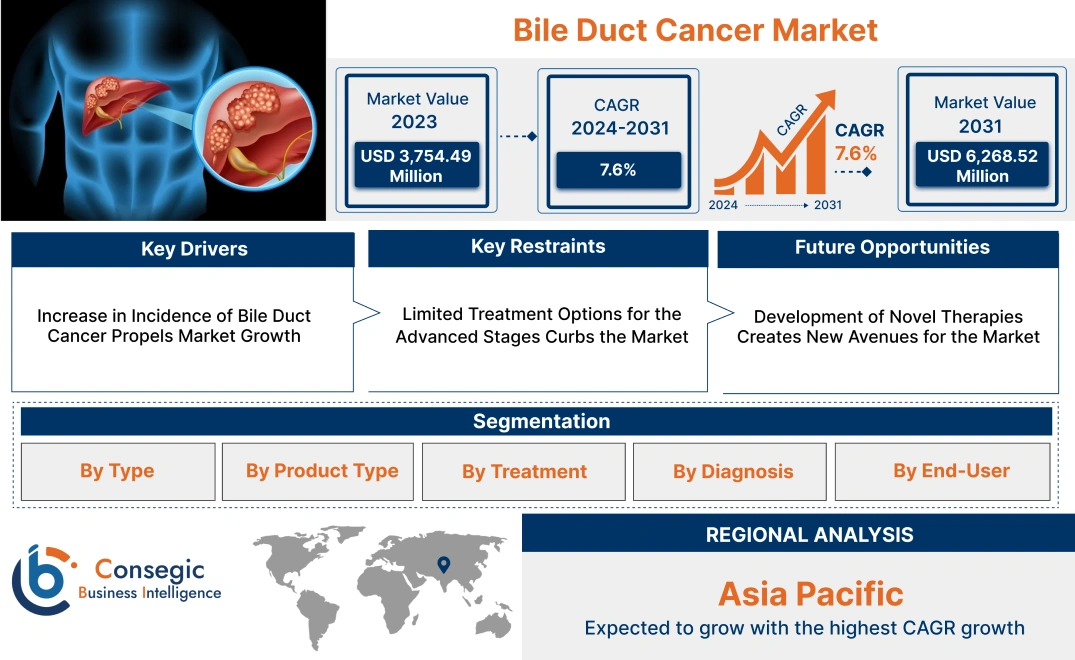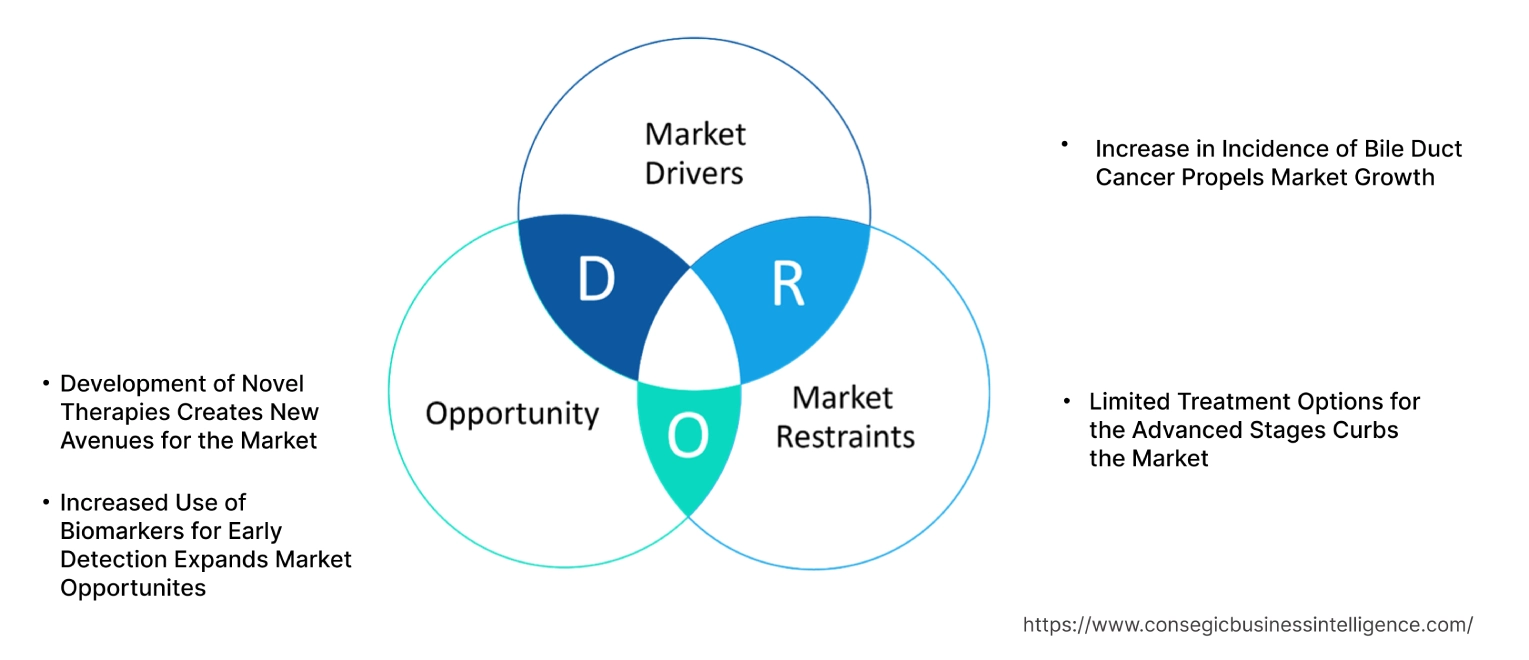- Summary
- Table Of Content
- Methodology
Bile Duct Cancer Market Size:
Bile Duct Cancer Market size is estimated to reach over USD 6,268.52 Million by 2031 from a value of USD 3,754.49 Million in 2023, growing at a CAGR of 7.6% from 2024 to 2031.
Bile Duct Cancer Market Scope & Overview:
Bile Duct Cancer, also known as cholangiocarcinoma, is a rare cancer variation that arises in the bile ducts. The bile ducts are slender tubes that carry the digestive fluid (bile) from the liver and the cholecyst (gallbladder) to the small intestine. This complex cancer type has no visible symptoms until it has advanced to later stages, though common markers include jaundice, itchy skin, abdominal pain, dark urine, etc. It can develop either within or outside the liver. The dysfunction which leads to cholangiocarcinoma is uncertain. Risk factors such as chronic bile duct inflammation, genetic mutations, diabetes, cirrhosis of the liver, etc., can lead to the development of cancer. This type of cancer has four stages and its general treatment is done through surgeries, therapies (chemo, targeted, and radiation), and palliative care. The market has its end users in the medical industry, research institutes, etc.
Bile Duct Cancer Market Insights:
Bile Duct Cancer Market Dynamics - (DRO) :
Key Drivers:
Increase in Incidence of Bile Duct Cancer Propels Market Growth
The prognosis of cholangiocarcinoma is challenging as it depends on its diagnosis, which has minimal detection chances during the early stages due to a lack of tangible symptoms. However, due to advancements made in the medical field, such as new imaging methods, molecular diagnostics, etc., a greater number of patients are being diagnosed with cholangiocarcinoma. This results in the expansion of treatment options provided by healthcare workers and pharmaceutical companies. This includes new surgical procedures (liver transplants, bile duct resection, etc.) and radiation therapy, chemotherapy, etc. It also results in a robust market for drugs aimed at enhancing the recovery and survival rates of diagnosed patients.
- In an online article updated on May 2024, by the American Cancer Society, it has been highlighted that on a yearly basis, around 8000 Americans are diagnosed with cholangiocarcinoma. This could include intrahepatic cholangiocarcinoma (inside liver) or distal cholangiocarcinoma (outside liver). It also underscores the growing concentration of cholangiocarcinoma in Southeast Asia.
Thus, as the awareness around the effects of cholangiocarcinoma due to new research and development spreads it drives the bile duct cancer market growth.
Key Restraints :
Limited Treatment Options for the Advanced Stages Curbs the Market
The later stages of cholangiocarcinoma curative treatment options are minimal. The metastatic stage surgeries are often not feasible due to the considerable spread of the cancerous cells. This leaves chemotherapy as the most productive treatment variation, and in certain special cases, targeted drug therapies. However, such treatment options have low survival rates, resulting in reluctance from the patient's side to indulge in medical care. The advanced stages also have a shorter duration of treatments, adding to their inefficiency in achieving better outcomes.
- An article published in February 2023 on Medical News Today discusses the survival rate of bile duct cancer patients. The 5-year survival rate of a cholangiocarcinoma patient (inside the liver) is around 2-24% whereas for those outside the live cholangiocarcinoma, it is 2-17%.
Thus, despite concurrent research and development processes, there is a heightened unmet medical need in the treatment of this cancer, restraining the bile duct cancer market demand.
Future Opportunities :
Development of Novel Therapies Creates New Avenues for the Market
Innovation in precision medicine and enhancement in genetic testing of mutations in cholangiocarcinoma has led to the development of new targeted therapies such as infigratinib (FGFR inhibitor). These new researches provide novel options for patients with particular genetic mutations or an understanding of molecular pathways that lead to the development of cancerous cells. There is also development in new immunotherapies, such as the introduction of drugs like pembrolizumab (immune checkpoint inhibitor drug). These new therapies are minimally invasive allowing for more efficient removal of tumors and high recovery rates. Pharmaceutical firms can monetize the production of cholangiocarcinoma drugs and diagnostic tools that are curative for early and advanced stages of prognosis.
- In September 2023, at the International Liver Cancer Association (ILCA) yearly conference, EASL unveiled its new therapy options for treating intrahepatic cholangiocarcinoma(iCCA) or cholangiocarcinoma within the liver. The EASL-ILCA is a set of evidence-based guidelines for healthcare workers for the treatment, diagnosis, and management of iCCA.
Therefore, these enhancements lead to new bile duct cancer market opportunities for treating cholangiocarcinoma at later stages countering the low traditional low-efficiency rates.
Increased Use of Biomarkers for Early Detection Expands Market Opportunites
Biomarkers, the biological molecules which are studied to indicate the presence of a disease can eradicate the lack of diagnosis of cholangiocarcinoma at nascent stages. Healthcare workers are adopting biomarkers for identifying the spread of cholangiocarcinoma before the appearance of risk factors, or the spreading of cancerous cells to other organs. Biomarker detection is also non-invasive as the detection is done by taking urine, bile, or blood samples. Moreover, every patient has a unique biomarker, resulting in the curation of personalized treatments for each patient. They help in monitoring the disease and detecting its repetition rates after treatments. The growth of genomics and proteomics are instrumental in the identification of new biological markers, enhancing the early detection rates and recovery treatment.
- In 2024, a study was published on ‘Molecular and Cellular Probes' on the utilization of biomarkers for early detection of intrahepatic cholangiocarcinoma (iCCA) and the development of customized pharmacological treatments. The study highlights the insurgence of iCCA in the Western nations and their low survival rates. They emphasize enhancements made in the prognosis of iCCA due to new innovative biomarkers and their integration into clinical practices for favorable outcomes.
Therefore, biomarker-targeted treatments help pharmaceutical firms develop precision medicine, driving the bile duct cancer market trends.
Bile Duct Cancer Market Segmental Analysis :
By Type:
The market is segmented based on type into Intrahepatic Cholangiocarcinoma, Extrahepatic Cholangiocarcinoma, and Distal Cholangiocarcinoma.
Trends in the Type:
- People around the age of 70-75 are more prone to developing intrahepatic cholangiocarcinoma.
- Recent statistics show that high mortality rates due to intrahepatic cholangiocarcinoma are higher in males than in females.
Extrahepatic Cholangiocarcinoma accounted for the largest revenue share of 38.42% in 2023.
- Extrahepatic cholangiocarcinoma (EHCC) occurs outside the liver and affects a larger proportion of patients leading to more diagnosis of this type of cholangiocarcinoma.
- The higher detection rates due to better diagnostic technologies such as CT scans, endoscopic retrograde cholangiopancreatography (ERCP), etc. are leading to more frequent treatments.
- EHCC treatments are expensive and have complex surgical procedures such as bile duct resection. They also have non-surgical processes such as chemotherapy.
- Thus, as per bile duct cancer market analysis, EHCC screening and curative treatments are costly, leading to its greater revenue generation.
Intrahepatic Cholangiocarcinoma is expected to have the fastest-growing CAGR during the forecasted period.
- Intrahepatic cholangiocarcinoma (iCCA) has a higher prevalence than EHCC since this type of cancer occurs within the liver.
- The enhancement of imaging techniques, liquid biopsies, molecular diagnostics, etc leads to better diagnosis, allowing for timely and effective treatment.
- The expansion of precision medicine has led to the development of new targeted drugs for iCCA treatments resulting in high recovery rates.
- Immunotherapies have led to the development of immune checkpoint inhibitors such as PD-1 that have shown clinical potential for effective iCCA treatment.
- Therefore, as per analysis, the rising awareness and better treatment for iCCA will lead to bile duct cancer market growth.
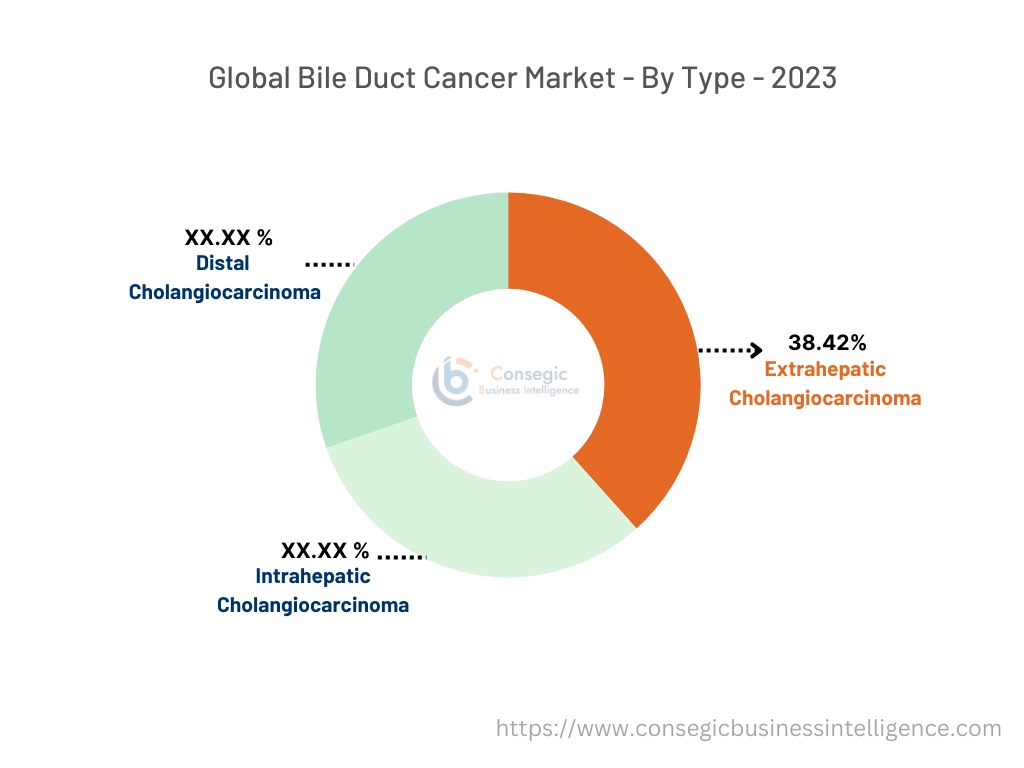
By Product Type:
The market is segmented based on product type into Gemcitabine, Cisplatin, Oxaliplatin, Capecitabine, and 5-fluorouracil (5-FU).
Trends in the Product Type:
- FDA approvals for targeted therapy drugs such as futibatinib (Lytgobi), ivosidenib (Tibsovo), etc. are surging.
- Patients receiving adjuvant treatment for cholangiocarcinoma have increased exponentially raising the survival rates.
Cisplatin accounted for the largest revenue of the total bile duct cancer market share in 2023.
- Cisplatin is a platinum-based chemo drug that is often combined with gemcitabine for treating advanced cholangiocarcinoma. The integration enhances its potential to control the progression of cancerous cells.
- It is comparatively less expensive and, hence, affordable to other variants such as oxaliplatin, for targeted drug therapies.
- Cholangiocarcinoma has a high recurrence rate, and when surgeries cease to be effective, cisplatin-based chemotherapy becomes the only viable option for prolonged treatment.
- Cisplatin has a high clinical efficacy for first-line treatment in improving patient treatment outcomes.
- For instance, an article published on NEJM Evidence, highlights how patients diagnosed with advanced cholangiocarcinoma have minimal prognosis, making the gemcitabine-based cisplatin imperative as the primary care method. The TOPAZ-1 trial evaluated durvalumab plus chemotherapy for patients with advanced cholangiocarcinoma.
- Thus, as per analysis, the insurgence of bile duct cancer has made cisplatin the largest revenue-generating segment in the market.
5-Fluorouracil (5-FU) is expected to have the fastest-growing CAGR during the forecasted period.
- 5-Fluorouracil (5-FU) is often integrated with oxaliplatin to treat cholangiocarcinoma. The advancements made in clinical trials for sustained-release formulations are increasing the effectiveness of 5-FU.
- 5-FU is extensively used in post-surgery and pre-surgery settings for generating more positive outcomes.
- The improvements made in pharmacokinetics and pharmacodynamics are enhancing the therapeutic potential of 5-FU in the reduction of side effects from targeted drugs.
- For instance, APEX Bio Technology LLC, a premier biotechnology company, offers 5-FU under Adrucil, as an anti-cancer agent.
- Therefore, as per analysis, as the treatment dynamics of cholangiocarcinoma are experiencing expansion 5-FU will boost the bile duct cancer market opportunities.
By Treatment:
The market is segmented based on treatment into Chemotherapy (Gemcitabine-Based Chemotherapy and Cisplatin-Based Chemotherapy), Radiation Therapy, Surgery (Liver Transplant and Bile Duct Resection), Targeted Therapy (FGFR Inhibitors and IDH1 Inhibitors), Immunotherapy (PD-1/PD-L1 Inhibitors and CTLA-4 Inhibitors), and others.
Trends in the Treatment:
- Recently there has been a rise in systematic treatment (chemotherapy, targeted therapy) to treat cholangiocarcinoma and address its recurrence rates.
- As a modern trend, Clinical trials for developing precision medicine for immunotherapies are offering better patient outcomes.
Chemotherapy (Gemcitabine-Based) accounted for the largest revenue share in 2023.
- There is a limited prognostic solution for metastatic cholangiocarcinoma as surgeries cease to be effective during the later stages. Gemcitabine-based chemotherapy is the standard and first-line treatment for the advanced stage of cholangiocarcinoma.
- Gemcitabine is often combined with cisplatin to increase its efficiency levels. This results in enhanced recovery and survival rates in patients.
- Even with the emergence of immunotherapies, the adoption and implementation remain slow, making chemotherapy the cost-effective option for treating cholangiocarcinoma.
- For instance, an article published in the National Library of Medicine (NLM) discusses how the Hepatic arterial infusion pump (HAIP) Chemo has a high survival rate. HAIP combined with floxuridine offers patients with advanced intrahepatic cholangiocarcinoma (iCCA) long-duration to live post-treatment.
- Thus, with the ongoing R&D for enhancing cholangiocarcinoma treatments, gemcitabine-based chemotherapy contributes to bile duct cancer market demand.
Targeted Therapy (FGFR Inhibitors) is expected to have the fastest-growing CAGR in the bile duct cancer market during the forecasted period.
- Targeted therapy, particularly fibroblast growth factor receptor (FGFR) inhibitors, offers precision medicine approaches to cure genetic mutations causing cholangiocarcinoma.
- This approach such as FGFR2 gene fusions affects healthy as well as cancerous cells increasing the efficiency of combating cholangiocarcinoma in patients with specific genetic conditions.
- Compared to chemotherapy or surgeries, targeted therapy has shown potential for progression-free survival rates in cholangiocarcinoma patients.
- For instance, a researcher from the University of Texas, MD Anderson Cancer Center, had developed a new FGFR inhibitor tinengotinib through clinical trials. It uniquely combines FGFR2. This targeted therapy offers patients to have high survival rates while simultaneously curbing the progression of the cancerous cells.
- Therefore, as the FDA approvals for FGFR inhibitors grow, they are primed to boost the bile duct cancer market trends.
By Diagnosis:
The market is segmented based on diagnosis into Imaging Tests (Ultrasound, CT Scan, and MRI), Biopsy, Endoscopic Retrograde Cholangiopancreatography (ERCP), and Blood Tests.
Trends in the Diagnosis:
- Recently, blood tests have proven itself effective in detecting the progression of cholangiocarcinoma.
- Novel imaging tests such as Positron emission tomography (PET) scans have recently raised the likelihood of detecting concealed metastatic cholangiocarcinoma.
CT Scan accounted for the largest revenue of the total bile duct cancer market share in 2023.
- CT scans offer accurate imaging of bile ducts (cholecysts), the liver, and other organs. This is instrumental in detecting the exact location of the tumor, its size, and its spread.
- CT scans are helpful in the early detection of cholangiocarcinoma as there are no symptoms during the nascent stages.
- CT scans allow oncologists to assess and evaluate the course of treatment. For example, it lets them decide whether the tumor is resectable or the cancerous cells have spread to surrounding organs.
- CT scans offer routine checkups and monitoring post-surgery to check the recurrence rates. Continuous monitoring can raise the overall positive outcome ratio.
- For instance, the detection of preoperative recurrence of intrahepatic cholangiocarcinoma (iCCA) is accurately detected using the CT scan method through the deep-learning (DL) algorithms, in a study published in an online journal ‘Scientific Reports'.
- Therefore, CT scans are expensive, which paired with their frequent use contributes to a larger revenue generation market.
Genetic Testing is expected to have the fastest-growing CAGR during the forecasted period.
- The rise in leveraging precision medicine in treating cholangiocarcinoma by focusing on genetic mutations benefits from genetic testing.
- The high demand for targeted therapies results in a high demand for genetic testing to identify the molecular markers specific to individual patients.
- The advancements made in genetic testing, such as liquid biopsy or next-generation sequencing (NGS) have driven up the accuracy rates of genetic testing. This has also made it affordable to detect genetic mutations for cancer in patients.
- Genetic testing can be integrated with immunotherapies to make identification of genetic markers more susceptible.
- For instance, an article published in the National Library of Medicine (NLM) discusses the viability and effectiveness of utilizing pathogenic samples, to reliably identify biliary tract cancer by genetic analysis.
By End-User:
The market is segmented based on end-users into Hospitals, Cancer Research Institutes, Specialty Clinics, Ambulatory Surgery Centers (ASCs), and others.
Trends in the End-User:
- Recently, ambulatory surgery centers (ASCs) have been offering minimally invasive surgical outpatient care for localized cholangiocarcinoma cases.
- In a recent trend, hospitals have raised the average 2-year survival rate of cholangiocarcinoma patients.
Hospitals accounted for the largest revenue share in 2023.
- Hospitals provide integrated diagnosis which includes CT scans, genetic testing, biopsies, etc. This increases the efficacy of detecting cholangiocarcinoma at an early stage.
- They have multidisciplinary teams and high-tech infrastructure for conducting complex surgeries such as liver transplants or bile duct resection.
- Hospitals often provide radiation therapy or chemotherapy as the primary treatment for metastatic cholangiocarcinoma.
- For instance, the Mayo Clinic is a leading hospital in the US that provides effective cholangiocarcinoma treatment. Their multidisciplinary team offers targeted and comprehensive care to individual patients.
- Thus, the hospital's effective infrastructure for treating cholangiocarcinoma makes treatment expensive, leading to larger revenue generation.
Cancer Research Institutes is expected to have the fastest-growing CAGR during the forecasted period.
- Cancer research institutes are gaining traction among patients as they are at the forefront of research and development for targeted therapy cures for cholangiocarcinoma.
- The rarity of detecting cholangiocarcinoma and the low survival rates have raised awareness among pharmaceutical firms, governments, and private companies to invest in cancer research institutes.
- The cancer research institutes are instrumental in developing biomarker-based therapies through advancements made in genomic research and NGS.
- Cancer research institutes are enhancing novel diagnostic tools such as molecular assays, liquid biopsies, etc. for managing cholangiocarcinoma.
- For instance, OSHU Knight Cancer Institute (America) is a pioneering cancer research institute that offers innovative diagnostics and treatment options for bile duct cancer. Their team of oncologists, surgeons, etc. offers advanced tests, Hepatic arterial infusion (HAI) therapy, molecular profiling, Palliative care, etc.
- Thus, as more awareness of cholangiocarcinoma grows, cancer research institutes will drive the market in the future.
Regional Analysis:
The regions covered are North America, Europe, Asia Pacific, the Middle East and Africa, and Latin America.
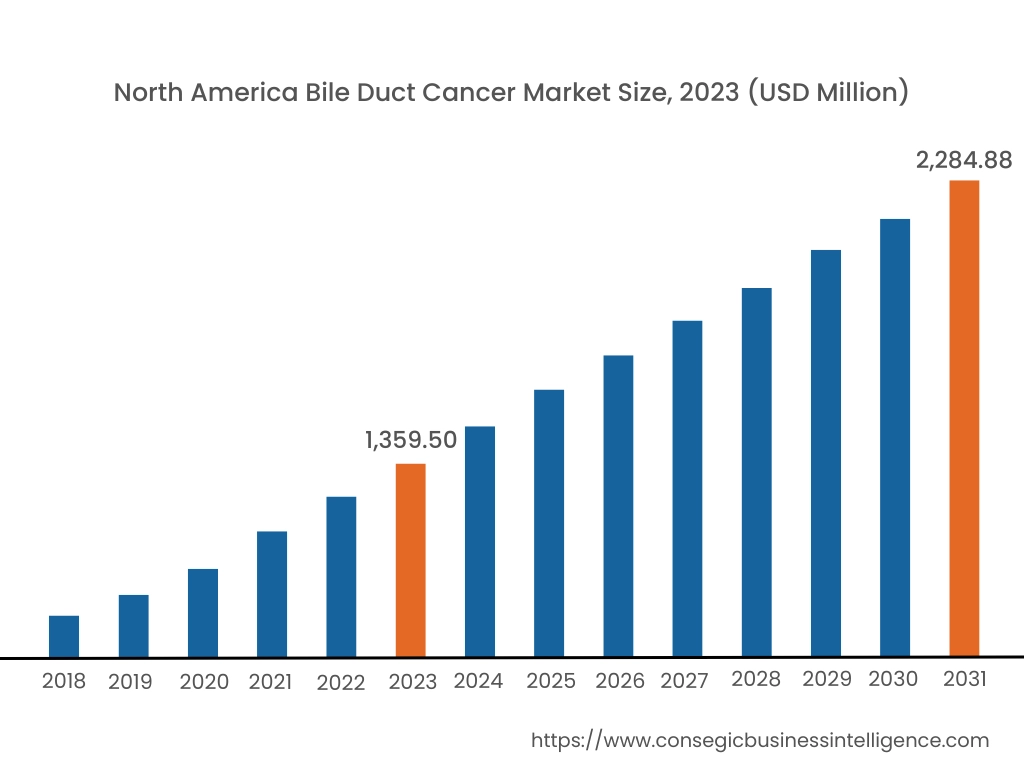
In 2023, North America accounted for the highest market share at 36.21% and was valued at USD 1,359.50 Million, and is expected to reach USD 2,284.88 Million in 2031. In North America, the U.S. accounted for the highest market stake of 71.14% during the base year of 2023. In North America, especially in the US and Canada, there is a well-structured healthcare sector. This has resulted in new advancements in cancer research and the development of new treatments for cholangiocarcinoma. The government also readily invests in research and development (r&d) for working on new targeted therapies, immunotherapies, integration treatment, etc. This has resulted in high early detection rates and high-tech medical care available, supporting the bile duct cancer market expansion.
- In 2022 an article was published by the National Cancer Institute discussing the FDA-approved Durvalumab (Imfinzi), an immunotherapy drug, that raises survival rates for bile duct cancer. The TOPAZ-1 when added to combined chemotherapy with gemcitabine and cisplatin has increased the duration a cholangiocarcinoma-diagnosed patient might live after beginning the treatment.
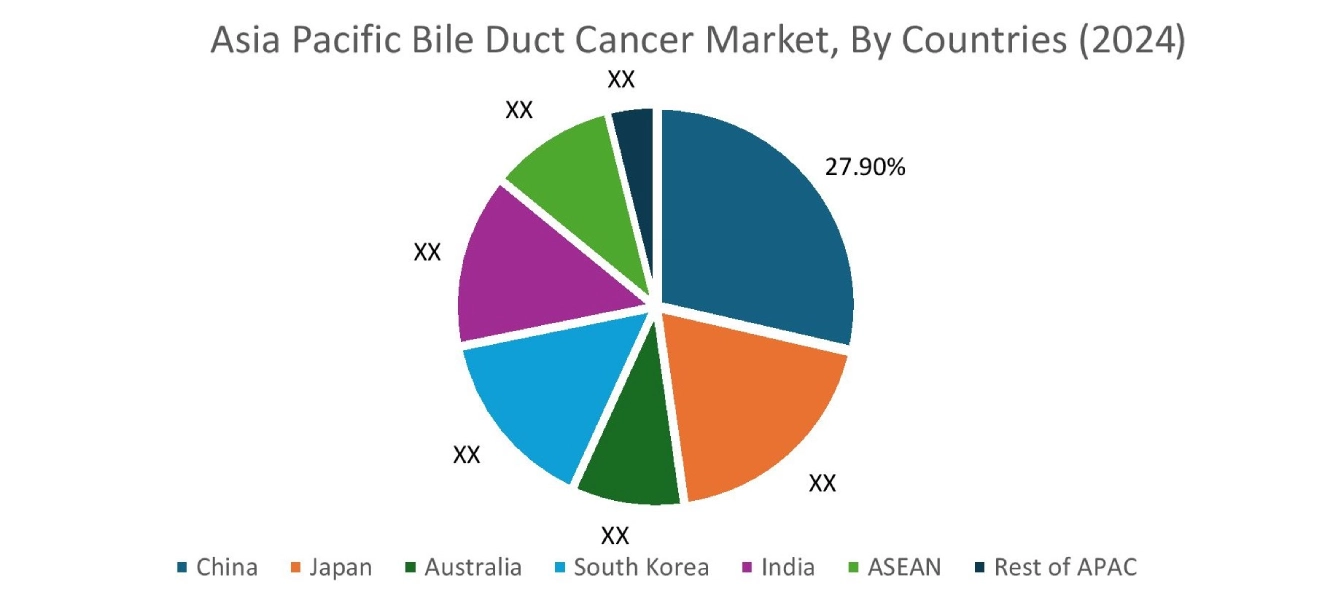
Asia Pacific is expected to witness the fastest CAGR over the forecast period of 8.2% during 2024-2031. As per the bile duct cancer market analysis, the Asia Pacific (APAC) region, especially Southeast Asian countries such as China, Vietnam, Korea, Japan, etc. have a high prevalence of liver fluke infections, hepatitis B and C infections, chronic liver disease, etc. These raise the risk factor of developing cholangiocarcinoma. The reasons behind this development might be traced back to their lifestyle such as consumption of raw or undercooked seafood.
- In February 2024, the Public Health Minister of Thailand revealed that the nation has the highest rates for bile duct cancer in the Southeast Asian region. The main risk factor influencing the high cholangiocarcinoma rates was identified as liver fluke infections.
Europe has the highest aging demographic concentration, especially in Germany, Italy, France, etc. The chances of developing intrahepatic cholangiocarcinoma (iCCA) are greatest among the age group of 70-75, thus there is a high-risk factor of developing cholangiocarcinoma here. It contributes to the bile duct cancer market expansion in the region. The Middle East and Africa (MEA) region, especially Saudi Arabia, UAE, etc experiences increased exposure to toxins as well as industrial pollutants. It is due to agricultural and industrial chemicals mixing with water, exacerbating the conditions of developing chronic conditions and this cancer. Latin America, especially in the metropolitan areas of Mexico, Brazil, etc, has seen a growth in public awareness of cancer treatments, including cholangiocarcinoma. This has led to the demand for more health monitoring raising the chances of early detection of this cancer.
Top Key Players & Market Share Insights:
The Bile Duct Cancer Market is highly competitive with major players providing products and services to the national and international markets. Key players are adopting several strategies in research and development (R&D), product innovation, and end-user launches to hold a strong position in the global bile duct cancer market. Key players in the bile duct cancer industry include:
- F. Hoffmann-La Roche AG(Switzerland)
- Novartis AG (Switzerland)
- Merck & Co., Inc. (USA)
- Bristol-Myers Squibb (USA)
- Lilly (USA)
- Pfizer Inc. (USA)
- Sanofi (France)
- AstraZeneca (UK)
- Bayer AG (Germany)
- Johnson & Johnson Services, Inc. (USA)
Recent Industry Developments :
Product Launches:
- In May 2024, the FDA sets a high priority level for Jazz Pharmaceuticals' biologics license application (BLA) for Zanidatamab for treating bile duct cancer. The Zanidatamab is a bispecific antibody that affects human epidermal growth factor receptor 2 (HER2). The drug combines two epitopes of HER2, blocks one HER2, and signals the removal of the other HER2 protein from cell surfaces. The drug is set to launch in November 2024.
- In June 2024, the FDA approves Merck's KEYTRUDA (pembrolizumab), a targeted therapy drug. The drug is aimed to have the most competent effect on adult patients suffering from metastatic (advanced) stages of Endometrial Carcinoma or the recurrent stage. The approval was issued based on its Phase 3 clinical trial (KEYNOTE-868) and could lower cholangiocarcinoma's progression and mortality rates.
Mergers & Acquisitions:
- In October 2023, Bristol Myers Squibb announced their acquisition of Mirati Therapeutics for $4.8 billion. Bristol Myers is a biopharmaceutical company whereas Mirati is a commercial-stage biotechnology firm. The merger allows Bristol to diversify their portfolio by adding a KRAZATI (adagrasib) inhibitor. The KRASG12C has US government approval for providing patients with systematic treatments.
Bile Duct Cancer Market Report Insights :
| Report Attributes | Report Details |
| Study Timeline | 2018-2031 |
| Market Size in 2031 | USD 6,268.52 Million |
| CAGR (2024-2031) | 7.6% |
| By Type |
|
| By Product Type |
|
| By Treatment |
|
| By Diagnosis |
|
| By End-User |
|
| By Region |
|
| Key Players |
|
| North America | U.S. Canada Mexico |
| Europe | U.K. Germany France Spain Italy Russia Benelux Rest of Europe |
| APAC | China South Korea Japan India Australia ASEAN Rest of Asia-Pacific |
| Middle East and Africa | GCC Turkey South Africa Rest of MEA |
| LATAM | Brazil Argentina Chile Rest of LATAM |
| Report Coverage |
|
Key Questions Answered in the Report
Who are the major players in the bile duct cancer market? +
The major players in the market include F. Hoffmann-La Roche AG (Switzerland), Novartis AG (Switzerland), Merck & Co., Inc. (USA), Bristol-Myers Squibb (USA), Pfizer Inc. (USA), Lilly (USA), AstraZeneca (UK), Bayer AG (Germany), Sanofi (France), and Johnson & Johnson Services, Inc.(USA).
Which region will lead the bile duct cancer market? +
North America will lead the global bile duct cancer market in the future.
What specific segmentation details are covered in the bile duct cancer market report? +
The bile duct cancer market is segmented into type, product type, treatment, diagnosis, and end-user industry.
Which is the fastest-growing region in the bile duct cancer market? +
Asia Pacific is the fastest-growing region in the bile duct cancer market.
